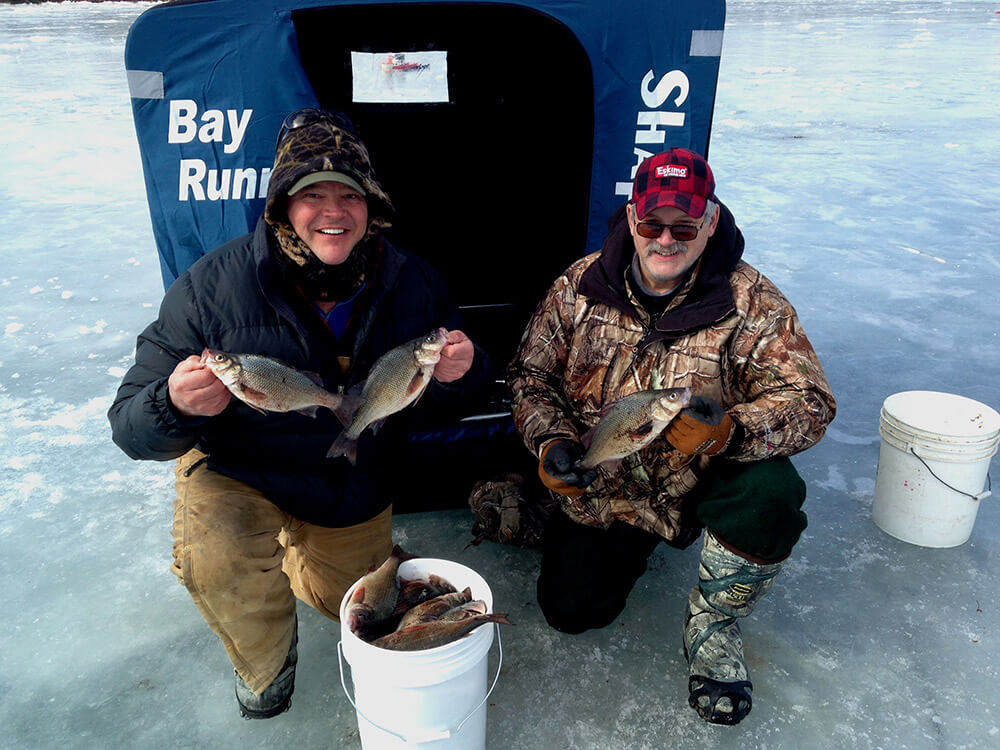Let’s go fishing

Come join the party! All are welcome—just make sure you have your fishing license!
The last week of February and first week of March are reserved for the Unofficial Great White Perch Festival on St. Albans Bay. Provided the ice is still safe (usually the bay has around two feet of good ice this time of year), you will find, on a sunny Saturday or Sunday, at least 100 people enjoying the ice fishing for Vermont’s favorite invasive species, the “white perch.”
“Whitey” is really from the genus Morone Americana, a member of the striped bass family. The shiny silver fish can grow up to 19.5 inches and weigh as much as four pounds; however, the ones we commonly see in the lake are more in the range of 10 to 14 inches. The Vermont Fish and Wildlife Department considers it an invasive species as its primary diet is yellow perch and walleye eggs, and it out-forages many other species for food. For some unknown reason they seem to migrate to St. Albans Bay in large numbers at this time of year.
Since they are considered invasive, there are no possession limits on the fish, and people frequently catch as many as a couple of hundred in a day, many of which are sold to fishmongers like Ray’s Seafood in Essex Junction. As their genus will dictate, they are great fighters and are quite delicious when fried or baked in a white wine and butter sauce with a light coating of bread crumbs and a squeeze of lemon.
Wanna’ join us? Go online to Vermont Fish and Wildlife and get yourself a license, then drive to the St Albans Bay Access off of Lake Road and take a hike southwest to Hathaway Point. You’ll see a crowd of people sitting near one another, and from a distance you will likely hear a staccato series of what sound like war whoops. Rods will be raising up quickly, setting hooks on the voracious whitey, and you’ll see people laughing and cajoling over “the one that got away.” Pull up a pickle bucket and pop a hole with your auger. If you don’t have one, just proceed to the nearest open hole, look around, and ask the nearest person if they mind if you try that one.
Bait your lure with a chunk of earthworm or a few “spikes” (maggots—for those not in the know) and lower your bait down just above the bottom of the bay, about 15–20 feet near the green buoy) and slowly start jigging—no, not the dance but the gentle up and down motion of the ice rod. Be aware, though, that if you do decide to do the dance, it is likely that a few folks who have gotten into their adult beverages a bit early may come join you.
Within a few minutes you should get a hard tug on the line, and when you do, set the hook quickly by raising your rod abruptly about one foot in the air. From that point on the fight is all yours! These fish love to pull, thrash and tug every which way they can, and when you’ve got a nice one on you’ll know it. Just keep reeling up and try to keep the line from abrading the edge of the hole because it can break against the sharp edge of the ice. Keep reeling. The rod will throb mightily and you will feel the full fight of the fish. Keep reeling. Keep the pressure on him.
When he finally gets up to the hole, you’ll need to finesse him through. Sometimes the hole (usually with about a 6-inch diameter) looks like it’s going to be too small to pull this feisty denizen of the deep through the cylinder of water. But wiggle the rod a little from side to side and gently ease his head first up through the hole. When his silvery head is above the surface, grab him by the mouth—not the gills and not the back, which can be very sharp gill plates or dorsal fins—but by the mouth, like the pro bass fishermen you see on television. Hoist him up high and let out your best war whoop! You’ve scored! Now, get back down there before they move to another hole.
Great Spirit, bless the invasive white perch, for tonight we shall dine with glory.
Bradley Carleton is executive director of Sacred Hunter, a nonprofit that seeks to educate the public on the spiritual connection of man to nature.

